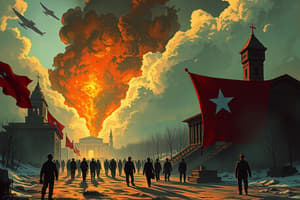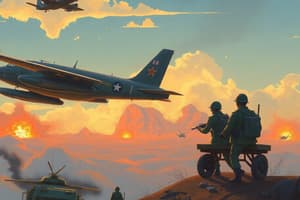Podcast
Questions and Answers
Which of the following events was created by the Western Allies in attempt to curb Soviet expansionism?
Which of the following events was created by the Western Allies in attempt to curb Soviet expansionism?
- The Warsaw Pact
- The Truman Doctrine
- The Molotov Plan
- The Marshall Plan (correct)
Which of the following terms, coined by Winston Churchill, symbolized the Soviet Union's efforts to isolate itself and its satellite states from open contact with the West and non-Soviet-controlled areas?
Which of the following terms, coined by Winston Churchill, symbolized the Soviet Union's efforts to isolate itself and its satellite states from open contact with the West and non-Soviet-controlled areas?
- Cold War
- Satellite States
- Berlin Wall
- Iron Curtain (correct)
What was the primary goal of the Truman Doctrine?
What was the primary goal of the Truman Doctrine?
The Truman Doctrine aimed to contain the spread of communism by providing military and economic assistance to countries threatened by communist expansion.
What was the name given to the boundary dividing Europe into East and West from the end of World War II in 1945 until the end of the Cold War in 1991?
What was the name given to the boundary dividing Europe into East and West from the end of World War II in 1945 until the end of the Cold War in 1991?
The Berlin Blockade was successful for the USSR, effectively preventing the Western Allies from supplying West Berlin.
The Berlin Blockade was successful for the USSR, effectively preventing the Western Allies from supplying West Berlin.
What triggered the Soviet-Yugoslav split in 1948?
What triggered the Soviet-Yugoslav split in 1948?
The Korean War was primarily fought by Korean conflicting social systems, as Bruce Cummings argued.
The Korean War was primarily fought by Korean conflicting social systems, as Bruce Cummings argued.
What event is widely considered to have marked the beginning of the Cold War?
What event is widely considered to have marked the beginning of the Cold War?
What doctrine did the US adopt in response to the perceived threat of Soviet expansionism?
What doctrine did the US adopt in response to the perceived threat of Soviet expansionism?
What triggered the Cuban Missile Crisis?
What triggered the Cuban Missile Crisis?
What was the key factor that contributed to the thaw in relations between the US and USSR during the 1960s?
What was the key factor that contributed to the thaw in relations between the US and USSR during the 1960s?
Flashcards
Salami Tactics
Salami Tactics
A political strategy where a country gradually expands its influence through small, seemingly insignificant steps, avoiding potential confrontations.
Realpolitik
Realpolitik
The policy of dealing with other nations based on practical interests and objectives, rather than political doctrines or ethics.
Pragmatism
Pragmatism
The belief that the actions and consequences of something determine its meaning.
Idealism
Idealism
Signup and view all the flashcards
Iron Curtain
Iron Curtain
Signup and view all the flashcards
Long Telegram
Long Telegram
Signup and view all the flashcards
Truman Doctrine
Truman Doctrine
Signup and view all the flashcards
Marshall Plan
Marshall Plan
Signup and view all the flashcards
Bizonia
Bizonia
Signup and view all the flashcards
Division of Germany
Division of Germany
Signup and view all the flashcards
Potsdam Conference
Potsdam Conference
Signup and view all the flashcards
Yalta Conference
Yalta Conference
Signup and view all the flashcards
Percentages Agreement
Percentages Agreement
Signup and view all the flashcards
Warsaw Uprising
Warsaw Uprising
Signup and view all the flashcards
Tehran Conference
Tehran Conference
Signup and view all the flashcards
Truman Doctrine
Truman Doctrine
Signup and view all the flashcards
Soviet Bloc
Soviet Bloc
Signup and view all the flashcards
Soviet-Nazi Pact
Soviet-Nazi Pact
Signup and view all the flashcards
Atlantic Charter
Atlantic Charter
Signup and view all the flashcards
Lend-Lease
Lend-Lease
Signup and view all the flashcards
Comintern
Comintern
Signup and view all the flashcards
NATO
NATO
Signup and view all the flashcards
Emergence of Two Germanies
Emergence of Two Germanies
Signup and view all the flashcards
Berlin Blockade
Berlin Blockade
Signup and view all the flashcards
Berlin Airlift
Berlin Airlift
Signup and view all the flashcards
Trizonia
Trizonia
Signup and view all the flashcards
Soviet Atomic Bomb
Soviet Atomic Bomb
Signup and view all the flashcards
Warsaw Pact
Warsaw Pact
Signup and view all the flashcards
Korean War
Korean War
Signup and view all the flashcards
Geneva Spirit
Geneva Spirit
Signup and view all the flashcards
Acheson Perimeter Speech
Acheson Perimeter Speech
Signup and view all the flashcards
COMECON
COMECON
Signup and view all the flashcards
OEEC (Organization for European Economic Cooperation
OEEC (Organization for European Economic Cooperation
Signup and view all the flashcards
ECSC (European Coal and Steel Community)
ECSC (European Coal and Steel Community)
Signup and view all the flashcards
Cominform
Cominform
Signup and view all the flashcards
Rollback policy
Rollback policy
Signup and view all the flashcards
Domino Effect
Domino Effect
Signup and view all the flashcards
Cold War
Cold War
Signup and view all the flashcards
Study Notes
Origins of the Cold War
- 1939: Soviet-Nazi Pact
- 1941: Atlantic Charter
- 1941: Creation of the Grand Alliance
- 1941: Lend-Lease
- 1943: Tehran Conference
- 1943: Liberation of France and Italy (Western Allies)
- 1944: Liberation of Finland, Poland, Romania, and Bulgaria (Eastern Allies)
- 1944: Warsaw Uprising
- 1944: Percentages Agreement
- 1945: Yalta Conference
- 1945: Potsdam Conference
- 1945: Creation of the United Nations
- 1947: Long Telegram
- 1947: Truman Doctrine
- 1947: Bizonia
- 1947: Iron Curtain
- 1947-1948: Soviet Bloc
- 1948: Marshall Plan
- 1945-1990: Iron Curtain
Studying That Suits You
Use AI to generate personalized quizzes and flashcards to suit your learning preferences.




